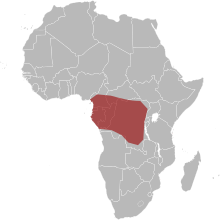Many-banded snake
| Many-banded snake | |
|---|---|
| Scientific classification | |
| Domain: | Eukaryota |
| Kingdom: | Animalia |
| Phylum: | Chordata |
| Class: | Reptilia |
| Order: | Squamata |
| Suborder: | Serpentes |
| Family: | Elapidae |
| Genus: | Naja |
| Subgenus: | Boulengerina |
| Species: | N. multifasciata |
| Binomial name | |
| Naja multifasciata (F. Werner, 1902) | |

| |
| distribution | |
| Synonyms[2] | |
The many-banded snake (Naja multifasciata), also known commonly as the burrowing cobra, is a species of venomous snake in the family Elapidae. The species is native to Central Africa. There are three recognized subspecies.
Geographic range
N. multifasciata is found in Angola, Cameroon, the Democratic Republic of Congo, Equatorial Guinea, Gabon, the Republic of Congo,[1][2] and the Central African Republic.[1][3]
Habitat
The preferred natural habitat of N. multifasciata is marshy areas of forest, at elevations up to 800 m (2,600 ft).[1]
Description
N. multifasciata is a small snake with an adult size of 50 cm (20 in) and maximum size of about 81 cm (32 in). The body is moderately slender with a short tail ending in a blunt spike. The head is short, flattened, and slightly distinct from neck; the neck region is not capable of expansion into a hood. The eyes are medium to moderately large. The pupils are round. The dorsal scales are smooth and glossy.[3]
Venom
N. multifasciata is venomous.[2][4] Its venom is similar to classical cobra venoms and appears to contain both neurotoxins and cardiotoxins.[4]
Reproduction
N. multifasciata is oviparous.[2]
Taxonomy
The genus Paranaja was synonymised with Naja in a recent molecular phylogenetic study, as this species is closely related to the forest cobra (Naja melanoleuca) [5]
Subspecies
Three subspecies are recognized as being valid, including the nominotypical subspecies.[2]
- Naja multifasciata anomala Sternfeld, 1917 – Cameroon
- Naja multifasciata duttoni (Boulenger, 1904)
- Naja multifasciata multifasciata (F. Werner, 1902)
Nota bene: A trinomial authority in parentheses indicates that the subspecies was originally described in a genus other than Naja.
Etymology
The subspecific name, duttoni, is in honor of British parasitologist Joseph Everett Dutton.[6]
References
- ^ a b c d Kusamba, C.; Chirio, L.; Gonwouo, N.L.; Zassi-Boulou, A.-G. (2021). "Naja multifasciata". IUCN Red List of Threatened Species. 2021: e.T110168688A110168696. doi:10.2305/IUCN.UK.2021-1.RLTS.T110168688A110168696.en. Retrieved 18 November 2021.
- ^ a b c d e Naja multifasciata at the Reptarium.cz Reptile Database
- ^ a b "Naja multifasciata". Clinical Toxinology Resources. University of Adelaide. Retrieved 8 March 2023.
- ^ a b Harvey, Alan L.; Rowan, Edward G.; Theakston, R. David G.; Warrell, David A. (2012). "First pharmacological study of the venom of a rare African snake, Naja multifasciata duttoni". Toxicon. 60 (2): 174. doi:10.1016/j.toxicon.2012.04.155.
- ^ Wüster W, Crookes S, Ineich I, Mané Y, Pook CE, Trape J-F, Broadley DG (2007). "The phylogeny of cobras inferred from mitochondrial DNA sequences: evolution of venom spitting and the phylogeography of the African spitting cobras (Serpentes: Elapidae: Naja nigricollis complex)". Molecular Phylogenetics and Evolution 45: 437–453.
- ^ Boulenger GA (1904).
Further reading
- Boulenger GA (1904). "Descriptions of Two new Elapine Snakes from the Congo". Annals and Magazine of Natural History, Seventh Series 14: 14–15. (Elapechis duttoni, new species, p. 15).
- Sternfeld R (1917). "Reptilia und Amphibia". pp. 407–510 + Plates XXII–XXIV. In: Schubotz H (editor) (1917). Wissenschaftliche Ergebnisse der Zweiten Deutschen Zentral-Afrika-Expedition, 1910–1911 unter Führung Adolph Friedrichs, Herzog zu Mecklenburg. Band 1, Zoologie. Leipzig: Klinkhardt & Biermann. 597 pp. + Plates I–XXVII. (Naja anomala, new species, pp. 482–484 + Plate XXIV, figure 9). (in German).
- Trape J-F, Roux-Estève R (1995). "Les serpents du Congo: liste commentée et clé de détermination [= Snakes of the Congo: Annotated List and Identification Key]". Journal of African Zoology 109 (1): 31–50. (in French).
- Werner F (1902). "Ueber westafrikanische Reptilien ". Verhandlungen der kaiserlich-königlichen zoologisch-botanischen Gesellschaft in Wien 52: 332–348. (Naia multifasciata, new species, p. 347). (in German).

